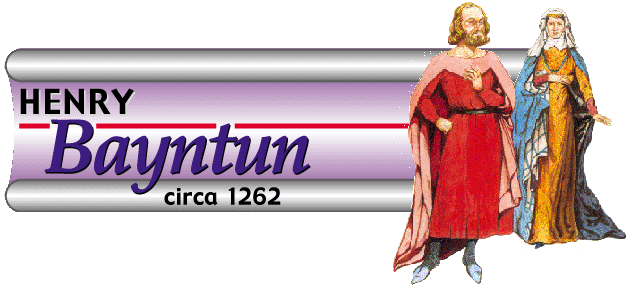|
Timeline
1272:
Henry III died at the age of 65, on 16th November at the Palace of
Westminster after being on the throne for 56 years and was buried at
Westminster Abbey, Middlesex. He was succeeded by his son Edward I “Longshanks”
who was 33 years old at the time.
1274:
Edward I was crowned King of England on 19th August at Westminster
Abbey, Middlesex.
1275:
Edward I created the first English Parliament after English knights
and townsmen joined the barons and bishops in a new council.
1297-1304:
England and Scotland were at war. Iron casting from moulds led to
more artillery on the battlefields. Gunpowder became popular and more
effective compared to rocks fired from the catapult and slingshot.
|

In
1262, Henry Bayntun and his wife Joan, gave land at Bradenstoke and
Tockenham to the Augustinian Priory
|
Married:
JOAN SINTON
The
daughter of Sir Hammond Sinton.
Children:
THOMAS BAYNTUN
(Son and heir 1300 -1358)
SIMON (Living 1300)
|

Engraving by Samuel & Nathaniel Buck (1820) – www.albion-prints.com |

It is now known when Henry Bayntun was born, however land deeds show him living in 1262. An early pedigree, listed in Burke's Peerage said he was married to Joan Sinton, the daughter of Sir Hammon Sinton. Other family trees have indicated that Joan was born in Worcestershire, England and that the marriage took place some time around 1272..
On the 9th February 1272, Westminster, Octave of Purification, dated 56 Henry III, Before Martin of Littlebury, Stephen Haym, Robert Fulcon, Justices. Between Geoffrey(I), Prior of Bradenstoke, quer., and Henry of Baynton and Joan his wife, imped. Thirty-one acres of land and one acre of meadow in West Tockenham. Plea of warranty of charter summoned. Henry and Joan recognised the land to be the right of the Prior, as of their gift. They also granted one messuage in Murefield, once held by Thomas of Tockenham, and a croft in the same township called Benecroft. To be held in alms of Henry and Joan. Warranty. Henry and Joan also quit-claimed their right in the common pasture which they used to have in the place called Hulewerk. In return the prior received them and their heirs into all future benefits and prayers in the church of Bradenstoke.
The Priory of Bradenstoke was dedicated to The Virgin Mary, and was the House of the Augustinian Canons. It was situated in the parish of Lyneham, near the village of Bradenstoke-cum-Clack. It stood on one of the highest ranges of land overlooking the Avon Valley, which commanded a fine view over an extensive tract of country into Somersetshire and North Wiltshire. It was also known as Clack Abbey, being a short distance from the village of Clack, about seven miles from Chippenham and four miles from Wotton Basset.
Bradenstoke acquired the Manor of Tockenham between 1232 and 1265 by grant of Thomas de Tockenham, its Lord. The Priory was founded in 1142 and although the Royal Charters of 1207 and 1232 confirmed no property here, the Priory had built a mill in Tockenham, to the detriment of a certain free tenant, between 1189 and 1194.
Today all that remains of this great Priory are two 14th century undercrofts and a tower, but the building stood intact up until 1928 before it was pulled down, despite pleas from the Society for its protection who battled hard to save it. It was then purchased by an American tycoon called William Randolph Hearst who stripped it of its great hall and magnificent prized fireplace (c1510), mostly transported to his own Hearst Castle in the US. The BradenstokeBarn too was shippped abroad in 109 cases. It was later sold to another buyer and today is housed in a giant warehouse where the 14th century timbers still remain in superb condition. Although the freight costs would be enormous, these crates could still be shipped back to England and reconstructed into what was a spectacular sight to have stood in Wiltshire.
The Bradenstoke Cartulary lists Walter Bayntun still occupying some land in Esteldewell, Tockenham in 1272.
In 1300, a Quit-claim Deed was issued, releasing Simon Baynton, the second son of Henry Baynton, of all his right in the lands and tenements which the Augustinian Canons held of his father’s inheritance in the township and territory of West Tockenham, and of the marriage portion of Joan Bayntun, his mother. A Quit-claim deed neither states nor guarantees that the person relinquishing their claim to the property had valid ownership, but it does prevent that person (the grantor) from later claiming they have an interest in the property.
When
Henry Bayntun died he was succeeded by his eldest son and heir Thomas
Bayntun
|




